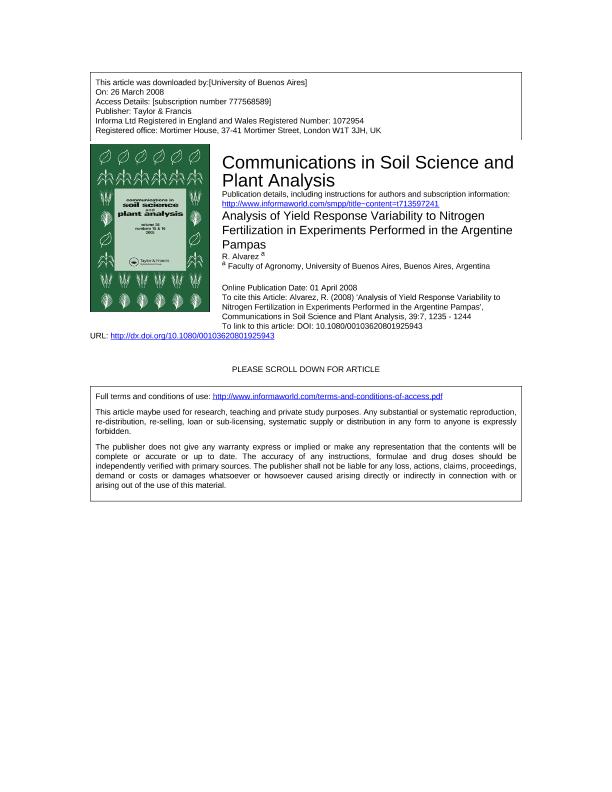Mostrar el registro sencillo del ítem
dc.contributor.author
Alvarez, Roberto

dc.date.available
2017-05-16T21:54:56Z
dc.date.issued
2008-12
dc.identifier.citation
Alvarez, Roberto; Analysis of yield response variability to nitrogen fertilization in experiments performed in the Argentine Pampas; Taylor & Francis; Communications In Soil Science And Plant Analysis; 39; 7-8; 12-2008; 1235-1244
dc.identifier.issn
0010-3624
dc.identifier.uri
http://hdl.handle.net/11336/16573
dc.description.abstract
Nitrogen (N) fertilization has become a common practice in corn and wheat crops in the Argentine Pampas during the past decade. In this region, great environmental variability determines erratic responses to fertilization. The quantity of data necessary for defining yield response models to N has not been investigated, and the relative yield transformation, combined with the total nutrient approach, has been widespread when analyzing fertilizer response results. The objectives were to determine the minimum data set necessary for fitting average yield functions suitable for fertilizer recommendation at regional scale and to investigate the consequences of using relative yield on N response functions when the total nutrient approach is used. Published results from two extensive fertilization networks, one with corn and the other with wheat, were used. Data were aggregated at different levels, because one single experiment to the entire network results, and yield response functions to N were fitted. Yield models tended to stability when a set of around 100 or more data points, generated in experiments performed across different sites and years, were used for fitting models with both crops. This amount of data was generated by performing 20 experiments in the corn network and 35 in the wheat network. Relative yield transformation allowed us to obtain models with lower dispersion than yield, but in the case of corn a biased model was generated that leads to underestimating fertilizer requirements. In wheat, similar fertilizer recommendations were produced from yield or relative yield functions. Response variability to fertilization must be addressed in the experimental area by increasing the amount of data used, rather than by applying the relative yield transformation.
dc.format
application/pdf
dc.language.iso
eng
dc.publisher
Taylor & Francis

dc.rights
info:eu-repo/semantics/openAccess
dc.rights.uri
https://creativecommons.org/licenses/by-nc-sa/2.5/ar/
dc.subject
Fertilization
dc.subject
Nitrogen
dc.subject.classification
Silvicultura

dc.subject.classification
Agricultura, Silvicultura y Pesca

dc.subject.classification
CIENCIAS AGRÍCOLAS

dc.title
Analysis of yield response variability to nitrogen fertilization in experiments performed in the Argentine Pampas
dc.type
info:eu-repo/semantics/article
dc.type
info:ar-repo/semantics/artículo
dc.type
info:eu-repo/semantics/publishedVersion
dc.date.updated
2017-05-16T20:37:15Z
dc.journal.volume
39
dc.journal.number
7-8
dc.journal.pagination
1235-1244
dc.journal.pais
Estados Unidos

dc.description.fil
Fil: Alvarez, Roberto. Universidad de Buenos Aires. Facultad de Agronomia; Argentina. Consejo Nacional de Investigaciones Científicas y Técnicas. Oficina de Coordinación Administrativa Parque Centenario; Argentina
dc.journal.title
Communications In Soil Science And Plant Analysis

dc.relation.alternativeid
info:eu-repo/semantics/altIdentifier/url/http://www.tandfonline.com/doi/abs/10.1080/00103620801925943
dc.relation.alternativeid
info:eu-repo/semantics/altIdentifier/doi/http://dx.doi.org/10.1080/00103620801925943
Archivos asociados
